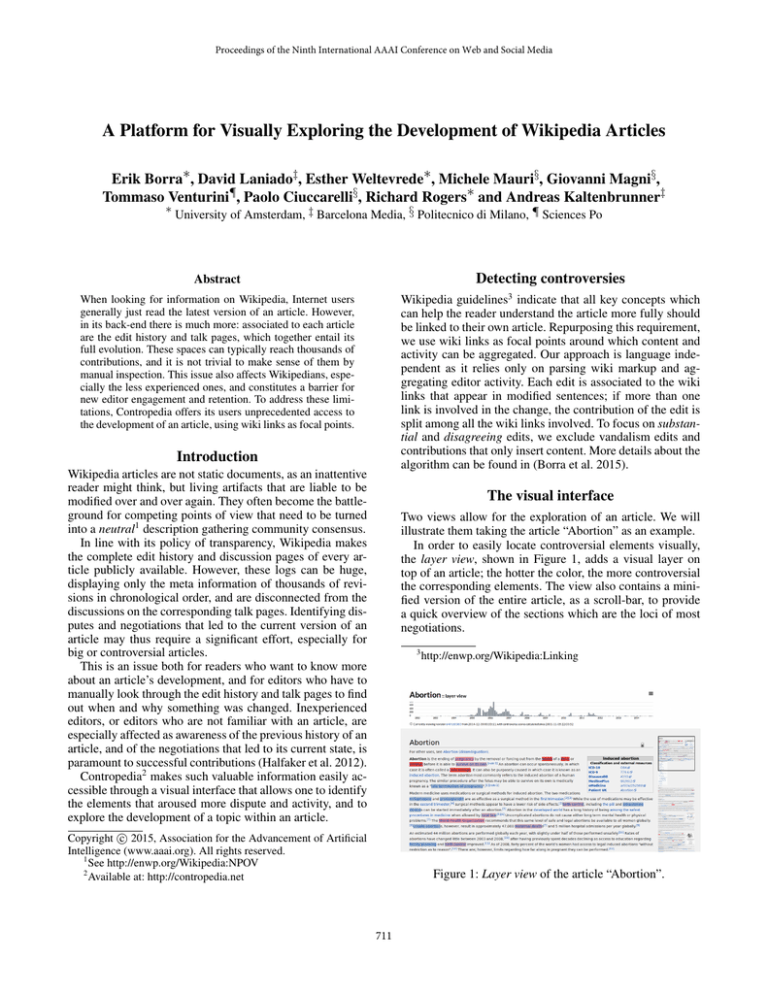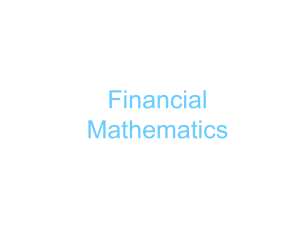
Proceedings of the Ninth International AAAI Conference on Web and Social Media
A Platform for Visually Exploring the Development of Wikipedia Articles
Erik Borra∗, David Laniado‡, Esther Weltevrede∗, Michele Mauri§, Giovanni Magni§,
Tommaso Venturini¶, Paolo Ciuccarelli§, Richard Rogers∗ and Andreas Kaltenbrunner‡
∗ University of Amsterdam, ‡ Barcelona Media, § Politecnico di Milano, ¶ Sciences Po
Abstract
Detecting controversies
When looking for information on Wikipedia, Internet users
generally just read the latest version of an article. However,
in its back-end there is much more: associated to each article
are the edit history and talk pages, which together entail its
full evolution. These spaces can typically reach thousands of
contributions, and it is not trivial to make sense of them by
manual inspection. This issue also affects Wikipedians, especially the less experienced ones, and constitutes a barrier for
new editor engagement and retention. To address these limitations, Contropedia offers its users unprecedented access to
the development of an article, using wiki links as focal points.
Wikipedia guidelines3 indicate that all key concepts which
can help the reader understand the article more fully should
be linked to their own article. Repurposing this requirement,
we use wiki links as focal points around which content and
activity can be aggregated. Our approach is language independent as it relies only on parsing wiki markup and aggregating editor activity. Each edit is associated to the wiki
links that appear in modified sentences; if more than one
link is involved in the change, the contribution of the edit is
split among all the wiki links involved. To focus on substantial and disagreeing edits, we exclude vandalism edits and
contributions that only insert content. More details about the
algorithm can be found in (Borra et al. 2015).
Introduction
Wikipedia articles are not static documents, as an inattentive
reader might think, but living artifacts that are liable to be
modified over and over again. They often become the battleground for competing points of view that need to be turned
into a neutral1 description gathering community consensus.
In line with its policy of transparency, Wikipedia makes
the complete edit history and discussion pages of every article publicly available. However, these logs can be huge,
displaying only the meta information of thousands of revisions in chronological order, and are disconnected from the
discussions on the corresponding talk pages. Identifying disputes and negotiations that led to the current version of an
article may thus require a significant effort, especially for
big or controversial articles.
This is an issue both for readers who want to know more
about an article’s development, and for editors who have to
manually look through the edit history and talk pages to find
out when and why something was changed. Inexperienced
editors, or editors who are not familiar with an article, are
especially affected as awareness of the previous history of an
article, and of the negotiations that led to its current state, is
paramount to successful contributions (Halfaker et al. 2012).
Contropedia2 makes such valuable information easily accessible through a visual interface that allows one to identify
the elements that aroused more dispute and activity, and to
explore the development of a topic within an article.
The visual interface
Two views allow for the exploration of an article. We will
illustrate them taking the article “Abortion” as an example.
In order to easily locate controversial elements visually,
the layer view, shown in Figure 1, adds a visual layer on
top of an article; the hotter the color, the more controversial
the corresponding elements. The view also contains a minified version of the entire article, as a scroll-bar, to provide
a quick overview of the sections which are the loci of most
negotiations.
3
c 2015, Association for the Advancement of Artificial
Copyright Intelligence (www.aaai.org). All rights reserved.
1
See http://enwp.org/Wikipedia:NPOV
2
Available at: http://contropedia.net
http://enwp.org/Wikipedia:Linking
Figure 1: Layer view of the article “Abortion”.
711
Figure 3: Network of users editing sentences that contain the
link “gestational age”.
sumes that interactions represent disagreement and assigns
the same color to editors who do not interact much with each
other, but interact with the same other editors.
Discussion
Similar to our layer view, WikiTrust (Adler et al. 2008) offers an overlay on Wikipedia articles. WikiTrust, however,
conveys the expected trustworthiness of content, while our
tool highlights which topics were the locus of most dispute.
Although platforms for comparing different linguistic versions of Wikipedia exist (Massa and Scrinzi 2012; Bao et al.
2012), they only consider the current version of an article
and do not dive into the edit history and talk pages in order
to disclose the social processes behind article development.
As our approach is language independent, our tool can be
used for the exploration of articles in multiple languages.
Previous work on Wikipedia controversies has mainly focused on detecting which articles are controversial. Contropedia’s display of what is controversial within an article as
well as when it was controversial, combined with the possibility to easily inspect the full edit and discussion activity
around a specific topic, makes Contropedia useful for editors, interested readers, as well as researchers, and can lower
the barriers to collaborate on Wikipedia.
Figure 2: Dashboard view of the most disputed elements in
the “Abortion” article, with a partial edit table of “pro-life”.
The dashboard view, shown in Figure 2, presents a ranking of the most controversial elements in an article. The gray
bar next to each element displays edit activity over time. The
thin colored bar below conveys when it was most disputed.
While in the layer view it is only possible to see the wiki
links available in the latest version of the article, the dashboard view also displays those that have been deleted. Such
elements are struck through, e.g. “pro-life” in Figure 2.
In both views, the timeline at the top of the page indicates
the number of edits per month for the full edit history; via
a menu it is possible to restrict the analysis to specific time
periods. Both views also allow for a more fine grained analysis of the edits related to, as well as comments from the
talk page mentioning, a specific element. Clicking an element displays the edit table which allows one to inspect all
the edited sentences containing, and comments mentioning,
the element. This way, edit activity and discussions related
to a specific element can be analyzed together, even though
they appear in two separate pages on Wikipedia. In the edit
table, text is highlighted in green when it was inserted and
in red if it was deleted in a specific edit. E.g., in Figure 2,
the edit table for “pro-life” is shown; the first entry displays
that the term “pro-life” was substituted by “anti-abortion”.
In the dashboard view, when one clicks on the number of
editors that are involved in editing a specific element, a network of disagreeing editors is shown (Figure 3). When an
editor makes an edit to a sentence which contains the element under analysis, an edge connects the editor to the previous editor of the sentence. The size of each node is proportional to the number of connections. One can thus see which
editors are central to the development of the topic. Colors are
assigned to convey camps of opposing editors, as described
in (Jacomy 2014): contrary to usual community detection,
but in line with our controversy measure , the algorithm as-
References
Adler, B. T.; Chatterjee, K.; De Alfaro, L.; Faella, M.; Pye, I.; and
Raman, V. 2008. Assigning trust to Wikipedia content. In Proc.
WikiSym 2008.
Bao, P.; Hecht, B.; Carton, S.; Quaderi, M.; Horn, M.; and Gergle,
D. 2012. Omnipedia: bridging the wikipedia language gap. In
Proc. CHI 2012.
Borra, E.; Weltevrede, E.; Ciuccarelli, P.; Kaltenbrunner, A.; Laniado, D.; Magni, G.; Mauri, M.; Rogers, R.; and Venturini, T. 2015.
Societal Controversies in Wikipedia Articles. In Proc. CHI 2012.
Halfaker, A.; Geiger, R. S.; Morgan, J. T.; and Riedl, J. 2012. The
rise and decline of an open collaboration system: How Wikipedia’s
reaction to popularity is causing its decline. Am. Behav. Scientist.
Jacomy, A. 2014. Antagonism-based community detection. http:
//github.com/jacomyal/ABCD-Gephi-Plugin.
Massa, P., and Scrinzi, F. 2012. Manypedia: Comparing language
points of view of Wikipedia communities. In Proc. WikiSym 2012.
This research was supported by EU FP7 EINS grant #288021.
712



![[edit] Government white papers](http://s3.studylib.net/store/data/009600724_1-6c511ef743ee2cfcf7d066843ef0ba8b-300x300.png)